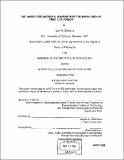Gut-associated microbial symbionts of the marsh fiddler crab, Uca pugnax
Author(s)
Gulmann, Lara K.
DownloadFull printable version (9.011Mb)
Other Contributors
Massachusetts Institute of Technology. Dept. of Biology.
Advisor
Lauren S. Mullineaux.
Terms of use
Metadata
Show full item recordAbstract
(cont.) bacterial phylotypes. An exception was the U. pugnax hindgut phylotype most closely related to a phylotype identified from hindguts of the detritivorous shrimp Neotrypaea califomiensis. This finding suggests that detritivorous crustacean hindguts may provide an ecological niche for specific bacterial phylotypes. Functionally, resident bacteria, particularly in the hindgut, may contribute to total enzyme activity in the gut of their host. Digestive associations between marine invertebrates and resident (attached) microbial communities may play a critical role in host physiology and involve previously unidentified microbial species. The overarching goal of this thesis was to characterize the ecology and genetic diversity of resident gut microbes to advance our understanding of their interactions with their host, the marsh fiddler crab, Uca pugnax. Furthermore, we assessed whether microbes benefit the host by contributing extracellular enzymes along the digestive tract. This is the first report of the eccrinid protists, Enteromyces callianassae and Enterobryus sp., inhabiting U. pugnax. The greatest abundances of both bacteria and protists were documented in the host stomach and hindgut. For these sections, we have described morphologies, measured abundances and characterized the genetic diversity (bacteria) of resident microbes. Presence and abundance of the Eccrinales protists depends on host molt stage as all eccrinid biomass is shed with the host's molt. In intermolt crabs, both bacterial and protozoan symbionts appear to be consistent features of the stomach and hindgut. Furthermore, bacterial diversity patterns seem to be comparable among individuals and over time, as assessed by denaturing gradient gel electrophoresis (DGGE). Community composition, however, does differ between stomach and hindgut populations, as resolved by DGGE and clone libraries of the 16S rRNA gene. Many recovered clones were most closely related to other symbiotic or gut-associated bacteria. Few identified clones, however, shared more than 95% 16S rRNA gene sequence similarity with their nearest known relatives, indicating that this environment may support novel
Description
Thesis (Ph. D.)--Massachusetts Institute of Technology, Dept. of Biology, 2004. Page 160 blank. Includes bibliographical references.
Date issued
2004Department
Massachusetts Institute of Technology. Department of BiologyPublisher
Massachusetts Institute of Technology
Keywords
Biology.